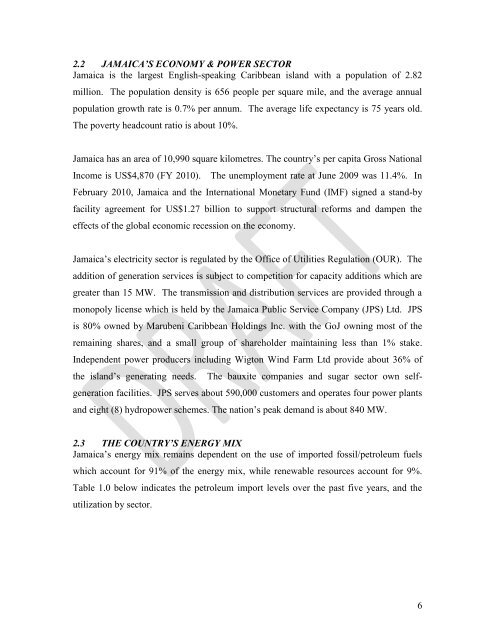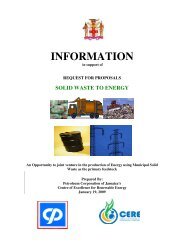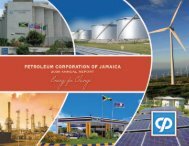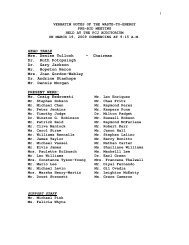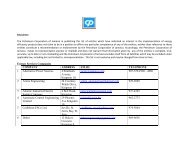terms of reference tor # mempcj201006037re - Petroleum ...
terms of reference tor # mempcj201006037re - Petroleum ...
terms of reference tor # mempcj201006037re - Petroleum ...
You also want an ePaper? Increase the reach of your titles
YUMPU automatically turns print PDFs into web optimized ePapers that Google loves.
2.2 JAMAICA’S ECONOMY & POWER SECTOR<br />
Jamaica is the largest English-speaking Caribbean island with a population <strong>of</strong> 2.82<br />
million. The population density is 656 people per square mile, and the average annual<br />
population growth rate is 0.7% per annum. The average life expectancy is 75 years old.<br />
The poverty headcount ratio is about 10%.<br />
Jamaica has an area <strong>of</strong> 10,990 square kilometres. The country’s per capita Gross National<br />
Income is US$4,870 (FY 2010). The unemployment rate at June 2009 was 11.4%. In<br />
February 2010, Jamaica and the International Monetary Fund (IMF) signed a stand-by<br />
facility agreement for US$1.27 billion to support structural reforms and dampen the<br />
effects <strong>of</strong> the global economic recession on the economy.<br />
Jamaica’s electricity sec<strong>tor</strong> is regulated by the Office <strong>of</strong> Utilities Regulation (OUR). The<br />
addition <strong>of</strong> generation services is subject to competition for capacity additions which are<br />
greater than 15 MW. The transmission and distribution services are provided through a<br />
monopoly license which is held by the Jamaica Public Service Company (JPS) Ltd. JPS<br />
is 80% owned by Marubeni Caribbean Holdings Inc. with the GoJ owning most <strong>of</strong> the<br />
remaining shares, and a small group <strong>of</strong> shareholder maintaining less than 1% stake.<br />
Independent power producers including Wigton Wind Farm Ltd provide about 36% <strong>of</strong><br />
the island’s generating needs. The bauxite companies and sugar sec<strong>tor</strong> own selfgeneration<br />
facilities. JPS serves about 590,000 customers and operates four power plants<br />
and eight (8) hydropower schemes. The nation’s peak demand is about 840 MW.<br />
2.3 THE COUNTRY’S ENERGY MIX<br />
Jamaica’s energy mix remains dependent on the use <strong>of</strong> imported fossil/petroleum fuels<br />
which account for 91% <strong>of</strong> the energy mix, while renewable resources account for 9%.<br />
Table 1.0 below indicates the petroleum import levels over the past five years, and the<br />
utilization by sec<strong>tor</strong>.<br />
6


